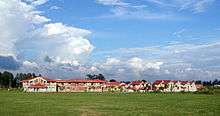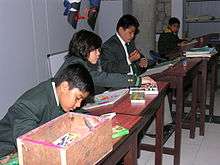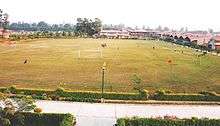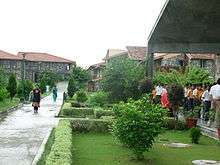SelaQui International School
| SelaQui International School | |
|---|---|
| Location | |
|
| |
| Information | |
| Founded | October 2000 |
| Founder | Mr Raghav Bhatia |
| Headmaster | Rashid |
| Website | www.selaqui.org |
The SelaQui School was established in October 2000 in Dehradun, a hill town in Uttar Pradesh (now in Uttrakhand). The founder, Mr. Om Pathak, is a former IAS officer of the Uttar Pradesh Cadre. Mr. Om Pathak has been closely associated with education and is the founder of DPS Ghaziabad and other educational institutions and bodies. In 2004, the SelaQui School was renamed SelaQui World School as it had been authorized to offer the International Baccalaureate Organization (IBO) Diploma Program. In 2010, the school became SelaQui International School (or SIS), due to an objection raised by the IBO on the use of the word ‘World’.
Campus

SelaQui’s name was inspired by the name of the village where it is situated, Selakui, which, in the local dialect means, ‘Shallow Well’. The campus is located 20 kilometers from Dehradun city, on the National Highway 72 going to Himachal Pradesh. Dehradun can be accessed by road, rail or air. The driving time from Delhi to SelaQui is 7 hours, while from Chandigarh, it is 4 hours.
The school is situated next to the Suvarna river, and is surrounded by greenery on all sides. SelaQui International School is affiliated to the Central Board of Secondary Education (CBSE), New Delhi. It is a fully boarding school, having around 300 students. The campus has 52 acres, with all facilities to support student life. With a natural stream flowing through the campus, it has a very serene, peaceful environment.
Academics

SelaQui International School starts from grade 6, when the child is around 10 years of age. The academic day starts at 8.30 AM and ends around 3 PM. The students get around 2 hours of self-study time. The school is in session 6 days a week, with 14 weeks break for the students in a year. The teachers have 9 weeks of leave in a year, while investing the remaining 5 weeks in self-enhancement and preparing for the upcoming terms.
There are around 35 full-time teachers in the school, with a teacher taught ratio of 1:8. Students appear for tests throughout the year to keep them in touch with their studies. They also appear for their mid term exams in September, and the finals in March every year. The grade 10 national level exams (CBSE) are held in March, and the results are declared in May. Successful candidates may continue in grade 11 ISC, or may shift to IB Diploma year 1. Students take their grade 12 national level exams (CBSE) in March every year, while IB candidates take their school leaving exams in May every year, the results of which are declared in July. The school has had 4 batches of students successfully complete the graduation requirements, with the 5th batch graduating in 2011.
The school is wirelessly networked and IB Diploma students are permitted the use of laptop computers for academic purposes, though it is not mandatory.
Students are assessed on their academic skills throughout the year, and also on the Cognitive, Affective and Psychomotor domains.
Facilities and Activities

The teachers act as personal tutors or foster parents for their group of students. There is a tuck shop to cater to the needs of the students. The school kitchen prepares vegetarian and non-vegetarian meals. The students laundry facility including dry cleaning for their woollen clothes. The school has a full-time doctor with support medical staff, and a psychologist to help students sort their emotional troubles.
The school has a well-stocked Learning Resource Centre (library) as well as a Digital Resource Centre. Students are permitted to call home once a week, and outings with parents are permitted once in six weeks.
Activities that students engage in include horticulture, art and craft, astronomy, chess, creative writing and editorial, public speaking, quizzing, theatre and drama, dance, photography and cooking.
Boarding
The school has separate boarding facilities for boys and girls. The boys and girls facilities are separated by the teachers’ residences and dining hall.
The hostels are on two floors, the ground floor housing the junior classes, and the first floor housing the senior classes. The juniors are accommodated seven to a room (dorm), with each child having a single bed, study table, closet, book rack, laundry bin and a window. The senior students are accommodated four to a room, with the same facilities as the juniors, but more spacious. Two dorms share a bathroom, having four shower stalls, four WCs and eight wash basins.
Each hostel has a recreation area where the students get together for 30–45 minutes in the evening after dinner, and enjoy TV shows, magazines, a game of table tennis, and conversation.
Sports

School sporting activities include soccer, cricket, rifle shooting, basketball, volleyball, swimming, tennis, table tennis, badminton and hockey. Students take up an individual sport as well as a team sport. SIS has sports camps where professionals interact with the students. It has also produced some state level and national level sportsmen. Students are taken for outdoor activities like hiking and rafting.
Community interaction

SelaQui International School lays emphasis on interaction with the local community and with the lesser privileged. Students of all ages take part in community programs like sapling donation, garbage collection, traffic management, blood donation (18+ years only), volunteering in hospitals, health and hygiene awareness programs in villages, teaching village children, visiting old age homes, and visiting schools for the mentally and physically challenged.
These community activities are part of the IB Diploma program, and non-IB students are also involved to sensitize them towards the society at large.
Governors of SelaQui International School
- Mr. Om Pathak, Chairman (ex-IAS, educationist)
- Maj. Gen. Basant Singh, Vice Chairman (decorated Army officer)
- Mrs. Niharika Pathak, Trustee
- Mr. RS Suri, Member (Supreme Court lawyer)
- Prof. MM Pant, Member (educationist)
- Mr. Rohit Pathak, Trustee (former Headmaster)
- Mr. Dilip Cherian, Member ( media personality)
- Mr. Anshul Pathak, Trustee (ex-CitiBank New York)
- Mr. Saurabh Srivastava, Member
External links
Coordinates: 30°22′15″N 77°51′23″E / 30.3707°N 77.8564°E